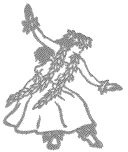
The Meaning of OLI
Aloha Kakou. One of my 'virtual students' wrote asking about the role of oli, or chant in the hula. She requested examples of oli that are appropriate for different hula uses and the explanation of those uses. I think that when there is one person who takes the time to ask the question there are most certainly others who have the same question but don't take the time to write or perhaps don't feel free to ask the question. For those others of you, here is some information with regard to the oli, it's uses and the reasons for those applications.
Oli have many different purposes in the hula. We must always begin by reminding ourselves of how important and powerful the spoken word was to the Hawaiian of pre-contact time. Having no written language that we know of, the entire history of a people, their stories, their social structure, their religious practices, their relationship to the land, to one another and to their gods was all recorded in the spoken word committed to memory by selected individuals. The memory of selected individuals was the library of that time. An ancient saying demonstrating the importance of the word is "In the word there is life, in the word there is death."

The myriad gods and guardians, great and small, were addressed with the most carefully chosen words delivered in the most pleasing way possible. This led to the refinement of the voice in the many styles reflected in the oli. It was of foremost importance that the oli be pleasing to the ears of the gods, and without flaw or error so that the gods would be pleased. There were, and are, oli for every occasion. Let’s look at some of the oli used for hula.
The first that comes to mind is the oli kahea - the request for entry into any space that is not your own. For the hula dancer it might be asking for entry into the halau, or into the forest to gather greens, or for entry into a sacred place such as a heiau. The most frequently used oli kahea for the hula dancer is "Kunihi ka Mauna" which requests permission to enter the halau hula, the hula stage or some other hula related space. This oli comes down to us from the epic story of Hi’iaka and Pele. It refers to sites on the island of Kaua"i. Kaua'i is the site of the first organized halau hula. That hula platform still exists today in Ha'ena. An oli kahea implies an oli komo from the kumu or other, to permit entry into the halau. If the oli is not done properly and pleasingly, there will be only silence from within the halau - no answering call to enter from the kumu. The usual oli komo from the kumu is "E hea e ke kanaka..."
A common oli for the dancer to use as they enter the stage area is "Ku Ka Punohu". It expresses the excitement of the crowd in anticipation of the hula they are about to witness. If one is entering a forested area to gather greenery, or for any other reason, the most common oli is "Noho ana ke akua". This asks permission of all the woodland beings and spirits whose home this is for permission to enter and to be safeguarded during the time in their domain. An oli to ask permission to enter a sacred place such as Mauna 'Ala, the resting place for many of Hawai'i kings and queens, is "Li'uli'u Aloha". A good starting place is the "Aloha Chant". It is of fairly recent composition in the form we use today, but it is a great all purpose chant that can be used in almost any situation or circumstance.
There are many oli written as a welcome for an event. These are too numerous to mention. We have oli we use to express our gratitude to the persons or places we have visited and been madeto feel welcomed. Indeed, there are oli for every imaginable event or situation. A study of these oliteach us so much about the thinking, attitudes and beliefs of those who came before. I encourage every hula dancer to learn and use some of these beautiful pieces of poetry.
